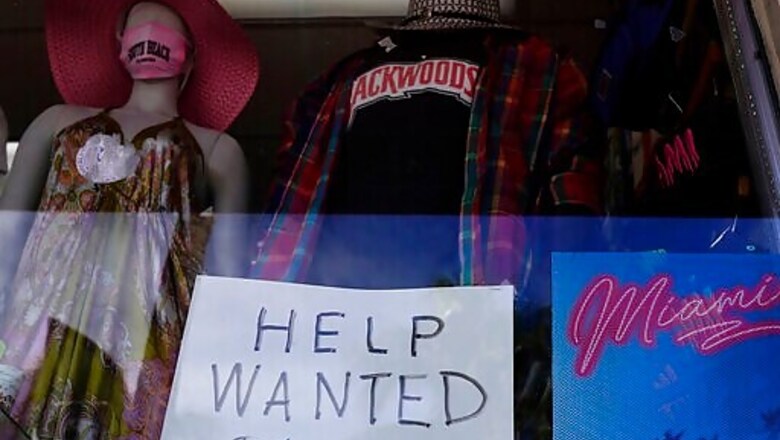
views
WASHINGTON: The struggles that have afflicted the American job market since the viral pandemic tore through the economy nearly a year ago are keeping a tight lid on hiring.
The Labor Department’s report Friday that employers added a meager 49,000 jobs in January, after having slashed 227,000 in December, did nothing to brighten that picture. Still, the unemployment rate slid to 6.3%, its lowest level since March, from 6.7% in December.
And January was the first month since June in which the economy generated more jobs than it did the month before: After a bounce-back of 4.8 million added jobs in June, net hiring had weakened to 1.7 million in July, 1.6 million in August, 716,000 in September, 680,000 in October and 264,000 in November and then actually shrank in December.
All told, the United States still has 9.9 million fewer jobs than it did in February last year, just before the coronavirus erupted across the country.
In a sign of potential relief, new confirmed COVID-19 cases have fallen in half, from a daily average of around 250,000 in early January to just over 120,000 more recently. Still, the caseload remains high, and numerous states and localities have maintained restrictions on business hours and capacity. In addition, many Americans have avoided shopping, traveling, dining out and attending mass events for fear of infection.
Sal Guatieri, senior economist at BMO Capital markets, called Januarys job gain underwhelming. But he added that the outlook is brightening as the vaccine rollout gains pace, and the jobless rate keeps tracking lower.
Here are five takeaways from the January jobs report:
APPEARANCES ARE DECEIVING
The job markets January performance, with hiring perking up after having sunk in December, may look good, but it aint, write Gregory Daco and Lydia Boussour of Oxford Economics.
The Labor Department, they note, revised down November and December payrolls by a sizable combined 159,000, revealing that employers were even more reluctant to hire than we knew. Quirks in the way the government uses seasonal adjustments to calculate job growth may also have made the January numbers look better than they actually were.
And the jobless rate is falling in part because so many Americans have stopped looking for work and are therefore no longer counted as unemployed.
Adjusting for the people that have dropped out of the labor force, by choice or obligation, the unemployment rate is above 9%, Daco and Boussour estimate.
CAUTION AMONG PRIVATE COMPANIES
Private employers added an anemic 6,000 jobs in January, accounting for a mere 12% of last months gain. Instead, the bulk of hiring came from state and local governments, which added 67,000 jobs, in part because schools reopened with some in-person learning in parts of the country. By contrast, the federal government shed 24,000 positions.
Leisure and hospitality companies, including restaurants, hotels and bars, lost 61,000 jobs last month. They now employ 3.9 million fewer people than they did in February 2020. Those businesses have absorbed the heaviest blow from pandemic restrictions on travel and from consumers reluctance to go out.
Retailers, in the meantime, lost 38,000 jobs. Health care companies cut 30,000 as many patients cancelled non-essential visits to doctors and dentists.
One encouraging sign: Jobs at temporary employment firms climbed by 81,000. That could point to stronger hiring to come because companies often hire temps to test the market before committing to permanent hires.
PERMANENT JOB LOSSES PILE UP
Most of the job gains since last spring have come from companies recalling workers they had furloughed after the virus hit. And so it was in January: The number of Americans on temporary layoff dropped by 293,000 to 2.7 million.
At the same time, the ranks of the permanently laid off climbed by 133,000 to 3.5 million. They have now outnumbered the temporarily jobless each month since September. In January, more than 4 million Americans were unemployed for at least six months, the highest such level since 2013. And they accounted for nearly 40% of the unemployed.
WOMEN LEAVE THE LABOR FORCE
In a worrisome trend, the pandemic is continuing to push women out of the U.S. workforce
In January, the number of women who either had a job or were looking for one dropped by 275,000, compared with a drop of only 71,000 for men. Since February, nearly 2.4 million women have exited the labor force, compared with fewer than 1.8 million men.
One reason is that women tend to work disproportionately in jobs most vulnerable to the pandemic at restaurants, beauty shops, hotels and doctors’ offices, for instance, and as child care workers and home health aides.
Another is that some women have had to quit jobs to care for children stuck at home until schools reopen.
Women account for nearly 54% of the jobs lost since February.
Last month was an exception to the pandemic trend, though: Women gained 87,000 jobs; men lost 38,000.
AFRICAN AMERICANS MAKE GAINS
Black Americans fared disproportionately well in the job market last month. Black employment rose by 262,000 to 18.3 million, and the Black unemployment rate fell to 9.2% from 9.9% in December. Hiring of whites (down by 4,000) and Hispanics (up 1,000), by contrast, was essentially flat.
Still, the white (5.7%) and Hispanic (8.6%) unemployment rates remained well below the rate for African Americans.
Disclaimer: This post has been auto-published from an agency feed without any modifications to the text and has not been reviewed by an editor
Read all the Latest News, Breaking News and Coronavirus News here




















Comments
0 comment